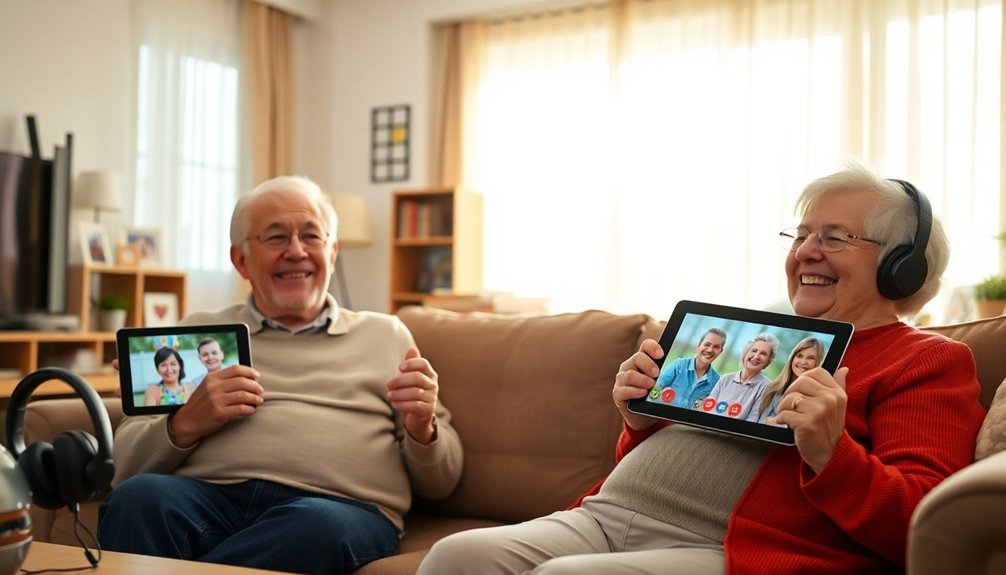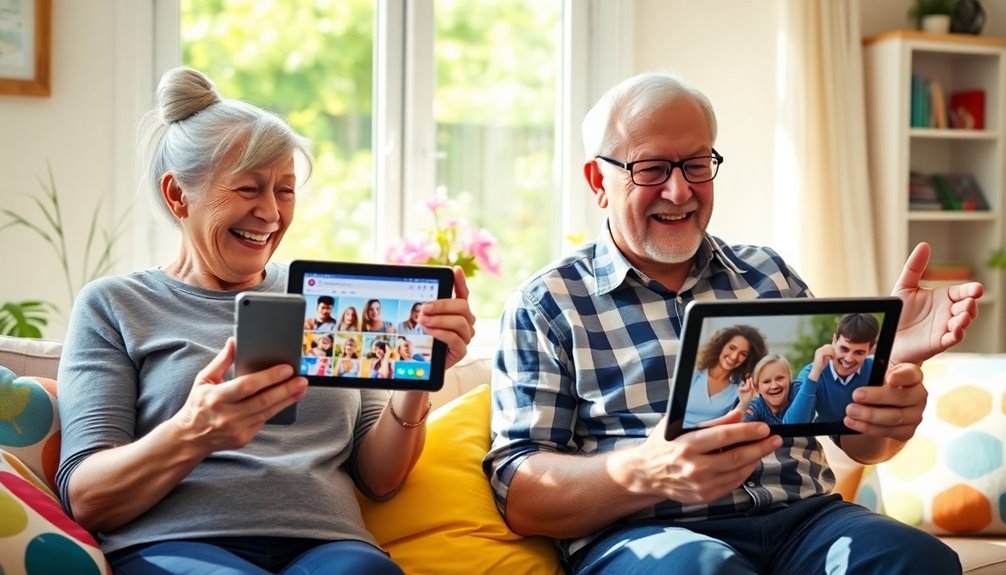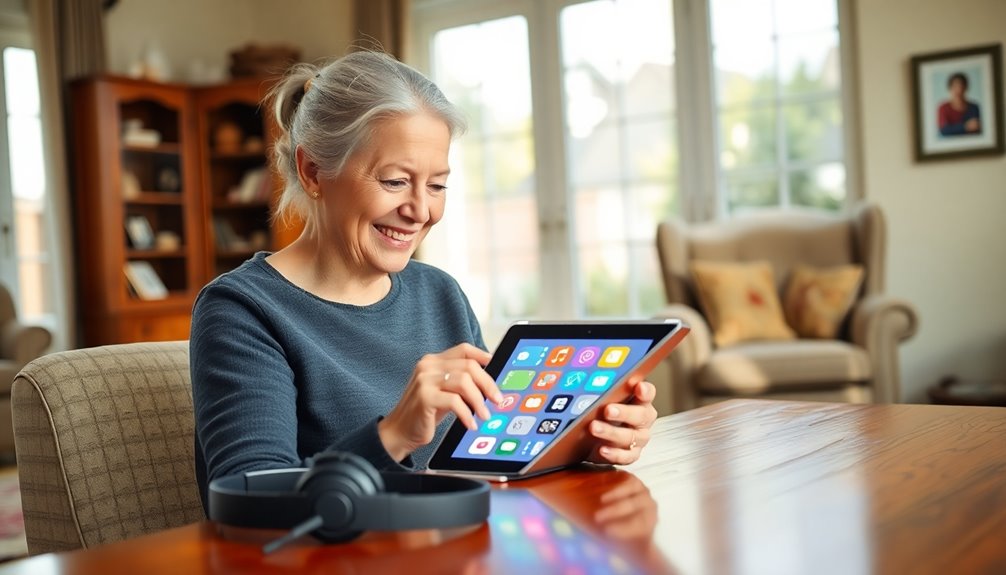You can enhance your communication with eight cutting-edge tools designed specifically for seniors. Start with smartphones and tablets for easy connectivity. Home devices and voice assistants make daily living easier. Video calling keeps you connected with family, while social media helps you engage with friends. Don't forget digital frames to display cherished memories, and communication aids that support interactions. Wearable technology guarantees your safety, and innovative apps keep conversations simple and enjoyable. There's much more to explore!
Key Takeaways
- Smartphones and Tablets: User-friendly devices with large screens and adjustable fonts enable easy communication and access to social media for seniors.
- Video Calling Apps: Platforms like FaceTime and Zoom reduce isolation and allow participation in family events, regardless of distance.
- Voice-Activated Assistants: These devices simplify daily tasks, set reminders, and support independence through hands-free operation for seniors.
- Wearable Technology: Features like fall detection and GPS tracking provide safety and peace of mind for both seniors and their families.
- Communication Aids: Tools like hearing aids and speech-to-text devices enhance interaction, address age-related challenges, and promote cognitive engagement.
Smartphones and Tablets: Bridging Generational Gaps

As technology continues to evolve, smartphones and tablets have become essential tools for seniors looking to bridge generational gaps. With 89% of adults over 50 owning smartphones and 59% owning tablets, these devices enhance communication and foster connections.
Features like large screens and adjustable font sizes make them user-friendly, empowering seniors to navigate with ease.
Social media platforms, like Facebook, allow you to stay connected with family and friends, while video calling apps such as FaceTime, Skype, and Zoom enable virtual interactions for family events, keeping relationships strong despite physical distance. Additionally, engaging with pet therapy can further enrich communication and emotional well-being among seniors, especially those coping with cognitive challenges.
Home Devices: Enhancing Daily Living

Home devices like voice-activated assistants can make your daily life easier and more organized.
You can set reminders for medications and appointments without lifting a finger, while also managing other smart home technologies. Additionally, these devices can help monitor energy usage, promoting energy efficiency in your home.
Voice-Activated Convenience
While many older adults may not yet own voice-activated home assistants, those who do often find them invaluable for enhancing daily living.
Voice-activated technology offers seniors a hands-free way to interact with their home devices, making it easier to set reminders for appointments and medications. These home assistants also enable you to create and share lists with family members, helping you stay connected and engaged in daily tasks.
By controlling other smart home devices, like Smart TVs, they provide unmatched convenience. With a simple interface, voice-activated tools support independence and social engagement, ensuring that technology feels accessible rather than overwhelming. Additionally, the integration of smart appliances can further simplify household management and improve overall comfort.
Embracing these communication tools can truly transform your daily experience.
Smart Home Integration
Integrating smart home devices can greatly enhance daily living for seniors, making it easier to manage tasks and stay connected. With home assistants and voice-activated controls, you can set reminders for appointments and medications without struggling with complicated interfaces.
This hands-free communication boosts your independence and enhances your overall quality of life. Smart devices also streamline entertainment by controlling Smart TVs and providing seamless access to information.
Plus, home assistants foster connectivity through collaboration; you can share lists with family members for grocery shopping or medication schedules, reducing feelings of isolation. Additionally, the integration of smart utilities like energy-efficient lighting and climate control can further improve comfort and safety in the home.
Video Calling: Staying Connected Virtually

As technology continues to evolve, video calling has emerged as an essential tool for seniors looking to stay connected with loved ones. This communication aid helps reduce feelings of isolation and fosters social interaction.
Here are three key benefits of video calling for seniors:
- Family Events: Participate in birthdays, holidays, and other gatherings, no matter the distance.
- Online Classes: Engage in learning opportunities and book clubs that keep your mind active and connected.
- Regular Visits: Maintain relationships through consistent virtual visits, especially during times of illness or when mobility is limited.
With user-friendly platforms like FaceTime, Skype, and Zoom, seniors can easily embrace this technology, ensuring they stay connected and involved in their communities.
Social Media: Engaging With Family and Friends

Social media's a great way for you to stay connected with family and friends, no matter the distance.
You can easily share life updates and photos, making it simple to rekindle old friendships and discover new interests.
Plus, engaging in online communities helps you feel more involved and less isolated.
Staying Connected Online
Connecting with family and friends online can be a game-changer for seniors, especially when it comes to maintaining relationships. Social media platforms like Facebook allow you to stay connected, reducing feelings of isolation and loneliness.
Here are three key benefits:
- Engage with Loved Ones: Keep up with family and friends' activities, enhancing your overall quality of life.
- Reconnect with Old Friends: Share personal updates and rediscover relationships that matter.
- Join Online Communities: Participate in groups and events, fostering new connections and compassionate care. Additionally, fostering a digital-friendly environment at home can enhance seniors' ability to navigate these platforms effectively.
Sharing Life Updates
While you mightn't see your loved ones every day, sharing life updates on social media keeps those connections strong. Platforms like Facebook allow you to post family photos and share personal milestones, fostering a sense of community and reducing feelings of isolation.
You can easily keep tabs on your loved ones' activities, ensuring they're safe while enhancing your involvement in family life. Participating in social activities online helps seniors maintain their independence and encourages meaningful interactions. Additionally, these platforms can promote the importance of celebrating relationships, helping to strengthen emotional bonds within families.
Discovering New Interests
As you explore social media, you may discover a wealth of new interests that can enrich your life. Engaging with platforms like Facebook opens doors to quality connections and support from loved ones.
Here are three ways social media can help you find new interests:
- Join Community Groups: Participate in groups tailored to seniors' hobbies, like gardening or painting.
- Reconnect with Old Friends: Share updates and rekindle relationships, discovering shared interests.
- Stay Informed: Follow pages that share events and activities, keeping you engaged and connected. Additionally, you can discover local attractions and their operating hours to plan outings with family and friends.
Digital Frames: Visual Reminders of Loved Ones

Digital frames offer a delightful way to keep cherished memories alive, allowing seniors to enjoy a rotating display of family photos right in their homes.
These engaging tools serve as visual reminders of loved ones, helping to combat feelings of loneliness and isolation. By displaying new photos that family members can upload remotely, you'll maintain strong connections without needing technical expertise.
Plus, many digital frames allow you to upload your own photos, adding personal touches that spark positive memories. This simple yet effective solution enhances emotional well-being, reminding you of special moments and the love surrounding you. Essential Gifts for Beagle Lovers can also serve as thoughtful ways to connect and engage with seniors, adding joy and companionship.
Embrace the joy of seeing familiar faces, and let these frames brighten your day, fostering deeper connections with family and friends.
Communication Aids: Supporting Interaction

Communication aids play a crucial role in helping seniors stay connected and express themselves effectively.
These tools can greatly enhance social interactions, boost mental health, and address age-related challenges. Consider these key communication aids:
- Hearing Aids: Amplifying sounds helps reduce isolation and fosters social connections.
- Speech-to-Text Devices: Perfect for seniors with visual impairments, they improve engagement by making conversations easier to follow.
- Large Text Displays: These enhance readability and encourage participation in discussions.
Using communication aids can also improve cognitive abilities, enabling seniors to maintain meaningful interactions. Additionally, many hearing aids now offer Bluetooth connectivity, allowing seniors to easily integrate them with smartphones for enhanced communication.
It's important to explore insurance options for these devices, as many plans might cover costs, making them more accessible for those in need.
Wearable Technology: Safety and Health Monitoring

Wearable technology has become a game-changer for seniors seeking safety and health monitoring. Devices like medical alert systems offer continuous monitoring, including fall detection features that guarantee immediate assistance during emergencies.
With GPS tracking, you can easily provide caregivers with accurate location information, enhancing your safety. Research shows that using these devices can reduce hospital readmissions by up to 40%, greatly improving your health outcomes.
Designed for ease of use, these wearable technologies empower you to maintain your independence while keeping loved ones informed. Real-time health data and alerts foster peace of mind for both you and your family, ensuring you're always connected and cared for, no matter where you are.
Innovative Apps: Simplifying Communication

Many seniors are finding that innovative apps can greatly simplify how they stay connected with family and friends.
These tools help combat social isolation and enhance their quality of life. Here are three popular options:
- FaceTime: Enables face-to-face conversations, making family gatherings feel closer.
- LifeLoop: Designed for seniors in care, it offers video calls, messaging, and photo sharing to reduce loneliness.
- Sagely: Keeps families updated on health and activity, promoting ongoing dialogue and care.
Frequently Asked Questions
What Are Communication Techniques Most Appropriate for Older Adults?
When considering communication techniques for older adults, focus on simplicity and clarity.
Use large text displays and adjustable font sizes to improve readability. Incorporate voice-activated controls to enable hands-free interaction.
Encourage video calling through platforms like FaceTime or Zoom to maintain personal connections, reducing feelings of isolation.
Finally, introduce digital frames that showcase family photos, allowing seniors to feel connected to loved ones without needing direct interaction.
How to Improve Communication With the Elderly?
To improve communication with the elderly, you should focus on using familiar technology. Encourage them to use smartphones or tablets for messaging and video calls, which can help bridge distances.
Introduce social media, like Facebook, for sharing updates and connecting with loved ones. You might also consider digital photo frames that display family pictures.
Finally, engaging them in online classes or community events can combat isolation and foster social interaction.
What Are the Three Types of Communication Tools?
When exploring communication tools, consider three main types: smartphones and tablets, which offer instant access and user-friendly interfaces; video calling platforms like Zoom and FaceTime, allowing for face-to-face conversations regardless of distance; and social media, such as Facebook, where you can share updates and reconnect with friends.
Each tool enhances your ability to stay connected and engaged, making it easier to maintain relationships and share experiences with loved ones.
What Are the Communication Tools for Dementia Patients?
It's amusing, isn't it? We often think of communication as a simple exchange, yet for dementia patients, it's a puzzle.
You'll find speech-to-text devices transforming spoken words into written ones, easing frustration. Visual aids like large text displays simplify understanding, while digital frames spark cherished memories.
Voice-activated assistants help with reminders, and social media keeps connections alive. Each tool plays a crucial role in bridging the gap, turning communication into a lifeline.
Conclusion
In a world that's constantly evolving, embracing these cutting-edge communication tools can truly enhance your life. Imagine the joy of video calling your grandchildren or sharing memories through digital frames. These technologies aren't just gadgets; they're lifelines that keep you connected and engaged. By harnessing these innovations, you're not just adapting to change—you're thriving in it. So why not explore these tools and discover how they can enrich your daily interactions? The future is at your fingertips!









